The 5 Best Garlic Presses
Dotdash Meredith and Yahoo Inc. may earn commission or revenue on some items through the links below.
I smashed over 80 garlic cloves to find a garlic press that made my life easier.
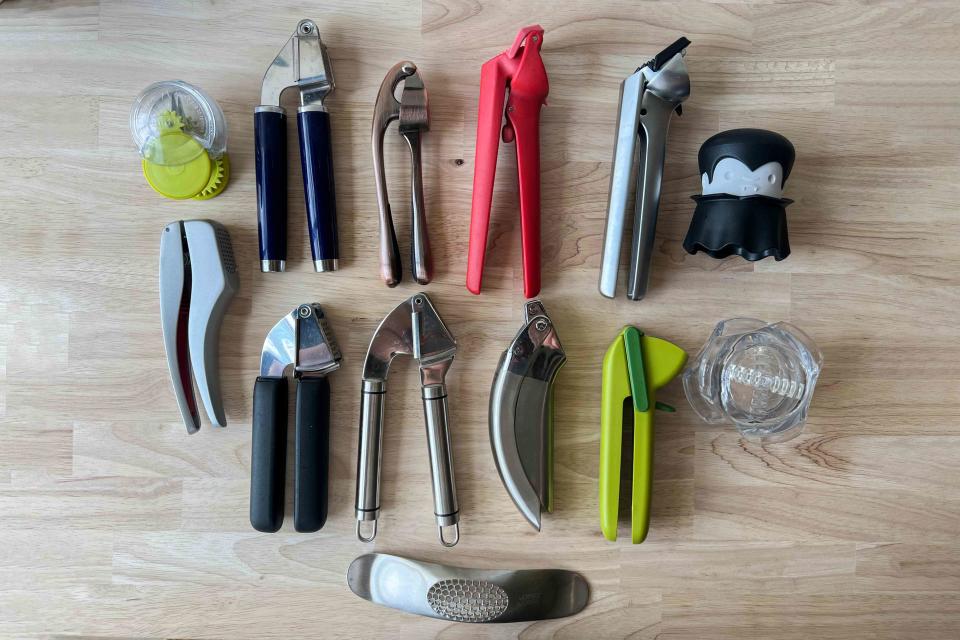
EatingWell / Katie Tuttle
I have a confession: I love garlic, but garlic presses? Not so much. While they appeal to me in theory, it’s the cleaning part that gets me. No one likes digging garlic peels out of one of these gadgets and then scrubbing the sticky mess out of a tiny cavity afterward. I have a garlic press, but it languishes somewhere in the jumble of my utensils drawer, forgotten and unloved. But here’s the thing—I use a lot of garlic. My husband and I joke that I'll automatically double the garlic despite the actual amounts a recipe may call for.
Turns out this isn’t necessarily a bad thing. Garlic has numerous health benefits, with some studies indicating that it may help prevent certain cancers and help lower cholesterol, blood sugar and blood pressure. It’s just extracting the garlic from the peel that poses a problem; while many of us love the taste of garlic, few want to smell it on their hands for hours afterward. Garlic presses propose to solve this problem, minimizing your contact with the clove and producing a mince ready for use in salad dressings, shrimp scampi and an amazingly versatile garlic butter.
When the time came to test garlic presses, I wanted to see if any would impress me enough to put it into regular rotation. I crushed cloves of garlic and knobs of ginger to find a garlic press that was easy to use, efficient and, most importantly, easy to clean. Here’s what I found.
Best Overall Garlic Press: Kuhn Rikon Epicurean Garlic Press
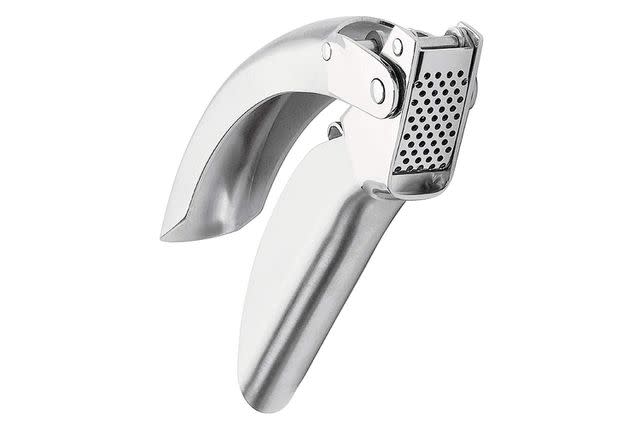
What we like: This garlic press produces a fine, uniform mince without much effort.
What to know: The Kuhn Rikon is one of the most expensive on our list.
One of the criteria I used during testing was how much mince each garlic press produced in relation to the exertion required to extract it. The Kuhn Rikon gave me the most garlic for the least effort of any traditional-style garlic presses I tried. It has some heft—it’s made entirely of stainless steel—but I didn’t find it overly clunky, and the added weight seems to help with garlic extraction. It’s smooth and folds neatly, and the hopper comfortably holds two garlic cloves.
I could easily press peeled cloves of garlic with one hand, and the Kuhn Rikon tackled unpeeled cloves without too much additional force. The sieve has round holes, producing a fine, uniform mince. While ginger was more of a challenge, it handled this task well, actually extracting ginger instead of merely smashing the fibrous root as many presses did.
Despite its price, the Kuhn Rikon does not come with any extras, such as a cleaning brush. However, the garlic basket swings away from the handle, making it easy to access for rinsing and removing leftover peel. While it is dishwasher-safe, the manufacturer recommends hand-washing to keep it in optimal shape. At around $50, it is an investment, but it feels well-made and durable and actually makes extracting garlic easier, and it was my overall favorite of the 15 models I tested.
Style: Press | Material: Stainless steel | Weight: 11 oz. | Dishwasher-safe? Yes
Also Great: Zulay Kitchen Premium Garlic Press Set

What we like: The Zulay is slim, elegant and works very well despite its minimalistic profile.
What to know: This garlic press can only accommodate one clove at a time.
As simple as the Zulay is, I didn’t expect to be as impressed with its performance as I was. I figured it was a case of form over function, as this is the best-looking garlic press I tested. It comes in eight colors (I tested the copper version) and is made of a zinc alloy that lends a surprising amount of heft. It has a slim, no-frills design, with a fixed hopper and a textured plunger that forces the garlic or other items through the sieve, which has small, rounded holes.
Despite its simplicity, I was very impressed by the quality of both the ginger and garlic mince this model produced. I didn’t need to use much force, even with unpeeled garlic cloves or ginger, and the mince was fine but uniform. It was also reasonably easy to clean. Though it comes with a garlic peeling sleeve and a cleaning brush, the plunger creates a puck of peel or leftover root that takes little effort to flick out. What kept this from being my favorite overall? It's small capacity. I could comfortably fit one clove of garlic in the basket; more than that, and I found the garlic would squish out over the sides. Still, if capacity isn’t your biggest concern, and your storage is limited, this would be an excellent tool to add to your kitchen.
Style: Press | Material: Zinc alloy, chrome, rubber | Weight: 7.9 oz. | Dishwasher-safe? Yes
Best Budget Garlic Press: Joseph Joseph CleanForce Garlic Press
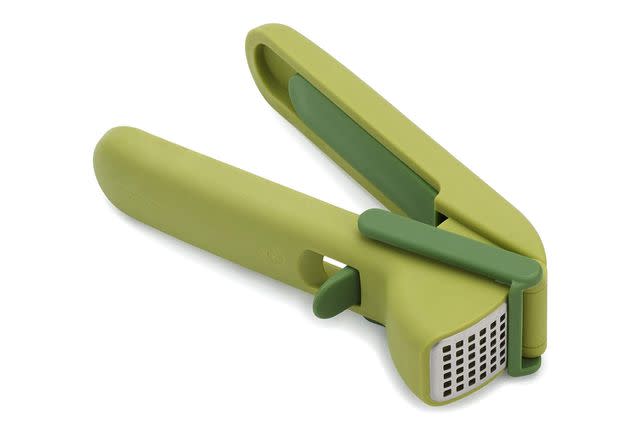
What we like: This garlic press has several features (a brush and scraper) that more expensive models don’t.
What to know: This model is made of plastic, so it feels a bit clunky when handling.
While I did test cheaper models, in terms of performance and what you get for your money, the Joseph Joseph CleanForce was a clear winner for me. Is it made of plastic? Yes. Does it have a cartoonish appearance? Also yes. However, it comes with a cleaning tool and a scraper to help you remove the mince from the sieve and has one of the largest hoppers of any press I tested. It handled unpeeled garlic cloves with aplomb, though I needed more force due to its lightweight construction. The CleanForce could have been more efficient in processing ginger root; it left little mince and quite a bit of fibrous leftovers in the hopper. Still, with the included cleaning tool, I could remove leftover debris without it coming in contact with my skin, which is a huge plus. The scraper feature also adds utility to a model you can get for just over $15.
Style: Press | Material: Nylon, stainless steel | Weight: 5 oz. | Dishwasher-safe? Yes
Best Multi-Purpose Garlic Press: NexTrend 4th Generation Clear Garlic Twister
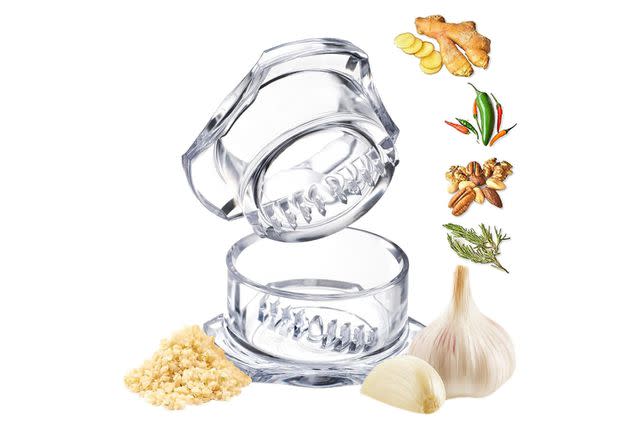
What we like: This twist-style model has a good capacity and can also serve as an herb mill or a quick way to grind nuts or chili peppers.
What to know: You must peel your garlic cloves before using this model, unless you enjoy picking the peels out of your garlic.
A twist-style garlic press is nothing new, but the NexTrend has a few design features that set it apart from the others. For one, it’s clear, allowing you to quickly gauge and adjust the coarseness of the item you’re grinding. When you’ve reached that ideal point, you wiggle the garlic twister a few times, and your minced garlic is deposited in neat triangles within the tool, making it easy to scoop out. The NexTrend left very little waste, effectively grinding up garlic and ginger root, though the initial twists as you break down the cloves or other items are more challenging to start.
What I liked about this take on the traditional garlic press was its capacity (I could fit four cloves at a time) and the fact that it could be used for other items. It worked quite well at milling some basil leaves I was using for a recipe and a serrano chile. The “teeth” did attract some debris, but I found a quick rinse took care of most of it. I will also add that if you have wrist issues, you will probably find the twisting motion needed to operate this tool uncomfortable. However, I am always leery of single-use kitchen tools, and the NexTrend makes me feel better about relinquishing precious drawer space.
Style: Twist | Material: Polycarbonate | Weight: 6.3 oz. | Dishwasher-safe? Yes
Best Garlic Press for Ease of Use: Chef'n GarlicZoom Garlic Chopper
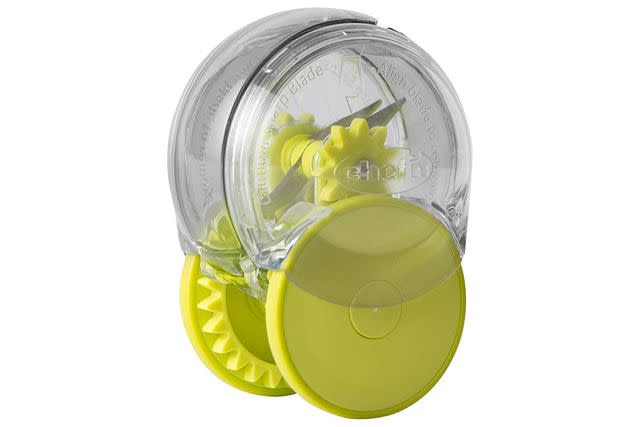
What we like: This little tool chops garlic without straining your wrists or testing your grip strength.
What to know: Taking the GarlicZoom apart to clean can be a hassle, and you must peel your garlic beforehand.
I actually owned an earlier version of the GarlicZoom, lured by the promise of a finely chopped garlic clove without having to touch the garlic. The interior blade was fiddly to remove, so I stabbed myself with it a couple of times, and then I lost it. So much for that experiment.
I’m happy to report that Chef’n has fixed some of the most irritating things about its previous model. For one, the blades only point in two directions, and the axle on which they turn is attached to the wheels of the GarlicZoom, so they are safer to remove for cleaning and harder to lose. For another, instead of one opening on the top, there are now two, which makes it much easier to access your garlic. To operate, place up to three peeled garlic cloves in the chamber and roll the GarlicZoom back and forth across your countertop. The longer you roll, the finer your garlic mince will be. The GarlicZoom leaves very little waste and made quick work of the ginger root and a few shelled walnuts I dropped in to sprinkle on top of my morning oatmeal.
While you still have to disassemble the GarlicZoom for cleaning, I found this to be by far the easiest to operate if you have wrist or grip strength issues. Rolling this little gadget across my countertop was easy, and the chamber is made of clear plastic, so I could gauge at a glance how finely chopped its contents were. This may be a good alternative if you struggle with a more traditional garlic press.
Style: Chopper | Material: Plastic | Weight: 3 oz. | Dishwasher-safe? Yes
The Bottom Line: The Best Garlic Press
For a traditional garlic press that minimizes waste and doesn’t test the limits of your grip strength, the Kuhn Rikon Epicurean Garlic Press (view at Walmart) was my favorite during testing. It produced a good amount of mince without herculean effort. However, if you have mobility issues and would prefer an alternative method of chopping garlic, you may want to consider the Chef’n GarlicZoom Garlic Chopper (view at Amazon); it’s efficient, effective and easy on the wrists and hands.
Choosing a Garlic Press
Ease of Use and Ergonomics
A garlic press shouldn’t be a test of grip strength; you should be able to handle the press comfortably and easily. While styles vary, a rocker-style or other model that doesn’t require a twisting or squeezing motion (like the GarlicZoom) may be a better option if, for example, you have arthritis.
When shopping for a traditional garlic press, look for ergonomically designed handles that fit comfortably in your hand. Non-slip grips, such as handles with a soft silicone or rubber grip, can be beneficial as they ensure a firm hold. If you have smaller hands, you may also prefer a press with a slimmer profile.
Material and Durability
Another point to consider when selecting a garlic press is the material it’s made from. Presses made from high-quality stainless steel or heavy-duty aluminum are more likely to resist rust and corrosion and tend to be more durable. They are also more likely to be dishwasher-safe, though all the models I tested (even the plastic ones) handled the dishwasher just fine.
Cleaning Mechanism
Cleaning a garlic press is arguably the worst part of owning one, so it’s important to choose one that simplifies this process. Many presses come with a built-in cleaning mechanism or a detachable component (like a brush or a pick) that makes cleaning easier. Presses that open fully and have easy-to-access parts can also help ensure no garlic residue is left behind.
Our Garlic Press Tests
For these tests, I put both cloves of garlic (both peeled and unpeeled) and small knobs of ginger through each press. I compared the resulting extractions for texture and quantity. For models that touted their ability to tackle other tasks, I threw in chili peppers, herbs and nuts to see if they lived up to their claims. During use, I also considered whether or not each garlic press was comfortable to hold and how difficult it might be to operate for folks with more limited grip strength. Finally, I judged each press on how easy it was to clean thoroughly and whether or not I was left cursing my luck with sticky garlic peels.
We Also Considered
Alpha Grillers Garlic Press and Peeler Set ($20 at Amazon): This press comes with a cleaning brush and a silicone sleeve for peeling your garlic without making contact with the cloves. (The motion of rolling the clove within the sleeve breaks down and removes the peel.) This press did a fine job, but it struggled with the ginger root. Overall, it’s still a solid, affordable choice.
Joseph Joseph Garlic Rocker ($24 at Amazon): This rocker-style garlic press has a lot going for it; it’s easy to store, doesn’t require a squeezing motion, and you can wipe your hands on the stainless steel handles to rid your skin of lingering garlic odors. However, the mince produced was coarse, and the surface area is small, making it no more efficient than a traditional style of garlic press.
Dreamfarm Garject Garlic Press ($55 at Amazon): This press is extremely heavy and has one of the bigger baskets of the garlic presses I tested. It comes with a button that is supposed to flick leftover peels out of the basket; however, I found this peel ejector did not make close enough contact with the bottom of the press’s basket and ultimately wasn’t that effective. For the price, the Kuhn Rikon does a better job.
OTOTO Gracula Garlic Crusher ($30 at Amazon): This is a cute concept (it looks like a little vampire!) and did its job well in the end, but the crusher is opaque, making it difficult to judge how thoroughly you’ve ground your garlic or other contents without opening it first. This would still be a cute gift for that friend who’s obsessed with Halloween year-round.
Common Questions
Do you need to peel garlic before using a garlic press?
You do not typically need to peel your garlic before using a garlic press. The press should still extrude the garlic from its clove, whether the skins are on or not. If your grip (or your press) isn’t very strong, you can cut off the stem end (where the clove joins the bulb) or quickly chop the clove in half before pressing. By leaving the skin on your garlic clove, you’re saving yourself time (which is the point of a garlic press) and the mess.
Of course, the exception to this are the garlic presses that crush or chop the garlic (such as the OTOTO Gracula Garlic Crusher, the NexTrend 4th Generation Clear Garlic Twister and the Chef’n GarlicZoom Garlic Chopper). In this case, you would need to peel the clove before using these devices, or you’ll end up with papery peel in your garlic.
What else can you use a garlic press for?
Garlic presses can be used for other items. If an item is small and a pain to chop, you may want to consider a garlic press. Olives for a tapenade? Garlic press. Ginger? Obviously. If you’re making an authentic Caesar dressing or a Bucatini alla Puttanesca, use it to mash those anchovies. If you like a bit of fresh horseradish on your prime rib, you can use a garlic press for that, too. Don’t let that press languish in your kitchen drawer—use it!
How do you clean a garlic press?
This is also what’s known as the worst part about a garlic press. However, some clever models make this less of a chore, coming with their own brushes or picks to help you dig out any leftovers. The most important thing is to clean your press immediately after using it, or at least soak it in some warm, soapy water until you can scrub it properly. Leftover garlic gets sticky, and you’ll have a much easier time cleaning it if you don’t wait.
Aside from the obvious, you’ll want to take it apart, removing the sieve if needed to make sure no bits of garlic or garlic peel are left in the press. While all of the models we tested are dishwasher-safe, you’ll likely still need to do some manual cleaning to ensure you get all the stuck-on bits.
Is chopping garlic better than using a garlic press?
Not necessarily; it’s mostly a matter of flavor preference and convenience. When a garlic clove is crushed or torn, it releases a chemical called allicin. This chemical gives garlic a more intense, “spicy” flavor. Chopping a clove releases less of this chemical than crushing or pressing; roasting a clove even less.
Convenience is also a factor; peeling and chopping garlic cloves takes time and transfers that garlic smell onto your skin—not ideal. A garlic press mostly avoids this, but you will still have to clean the press afterward.
Our Trusted Expertise
This article was written by Katie Tuttle, who personally tested each of these garlic presses. She was chosen for this test based on her lifelong (some might say irresponsible) love of garlic (her relationship with ginger is more complicated). In addition to contributing to publications such as Food & Wine and The Spruce Eats, she has spent the past two years testing meal delivery services and kitchen tools.
Read the original article on Eating Well.

